Text
How much protein should you eat?

The recommended daily amount (RDA) for protein is 0.8g per kg of bodyweight. At 175lbs (79kg) you would eat 63g of protein. Does that sound like enough? The RDA guideline is intended to meet minimum requirements for nitrogen balance in healthy moderately active people. Essentially, RDA is useful if your goal is to consume the minimum amount of protein to prevent disease. But what if you’re trying to gain muscle? Lose fat? Gain strength, improve performance, or improve your energy? If you’re thinking your protein needs might be higher, you’re thinking correctly.
Before we talk about protein requirements, I think it’s important that we mention weight training. Weight training is the catalyst for muscle growth. As you place greater stress on your muscle tissue by adding weight to the bar or reps to your sets we force the need for adaptation. The adaptation is larger and stronger muscle tissue to accommodate your next bout of exercise. The training is the catalyst and protein is the raw materials your muscles need to grow and recover.
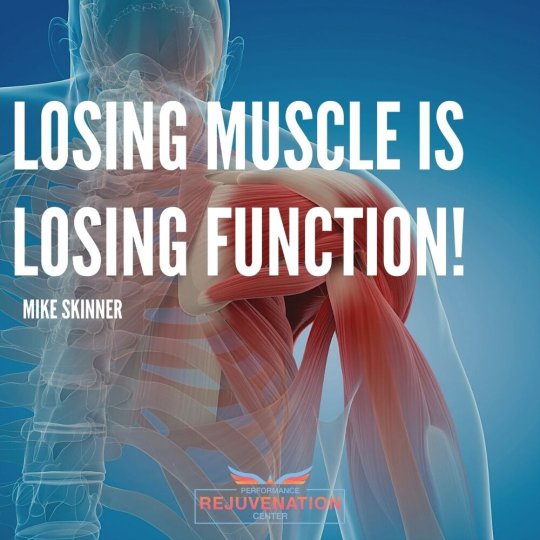
If you’re not consuming enough protein you may eventually fall short of your goals. Consuming too little protein too long and you could find yourself; lacking energy, experiencing prolonged soreness, with increased body fat, eventually loss of muscle (think flabby where muscle used to be), your hair may thin, be more prone to injury, and your cognition could suffer.
Protein makes up organs and muscles, helps with enzymatic processes to make energy, and it provides the building blocks for various hormones and amino acids that are used to make neurotransmitters for your brain. If there is not enough protein in your diet, your body will pull protein FROM your muscle tissue. Which can lead to the less than desirable effects mentioned above. All of these processes have a cost (the cost is dietary protein). This is why most lifters and athletes find that more protein is required than RDA for performance and physique improvement. You’re asking your body to do more “work” which requires more of an investment from dietary protein to meet all your body’s needs.
So how much?
A review published in the International Journal of Sports Nutrition concluded:
“Those involved in strength training might need to consume as much as 1.6 to 1.7 grams of protein per kilogram per day. While those undergoing endurance-based training might need 1.2 to 1.6 grams per kilogram per day.”
This means, for a weight trainer weighing 175lbs, a protein intake of 126g to 134g per day. For an endurance athlete, 95g to 126g would be needed per day.
In my own experience, whether in coaching or with myself, even more protein may be needed. Thankfully, there is research to support this. A study published in the International Journal of Sports Nutrition and Exercise Metabolism evaluated the effects of dietary protein on body composition in calorically restricted (burning more calories than consuming) resistance-trained athletes. It aimed to provide protein recommendations for these athletes.
Their results indicated “the range of 2.3 to 3.1 grams per kg of fat-free mass is the most consistently protective against the losses of lean tissue.” That’s 2-3g of protein per kg of lean tissue to conserve muscle mass. Continuing with our 175lbs example. This person could intake 158g to 237g of protein per day.
If you’re not an athlete and trying to lose fat how does this apply to you? Remember if you are trying to lose fat, you’re likely calorically restricted, and if the protein isn’t high enough you can lose muscle tissue. Losing muscle is losing FUNCTION! What do I mean? Well, carbohydrates are stored in the body in 2 main places 1. Your liver (stores ~100g) 2. Your muscles (~400g -The glycogen storage capacity of skeletal muscle increases as your muscle mass increases- read that again). When your body needs energy it can break down the stored carbohydrate (glycogen) and release it into the blood for your cells to use to make energy. If you’re losing muscle tissue, let's say fast-twitch fiber (where the majority of muscle glycogen is stored) you’re losing the ability to store glycogen. Remember more muscle means more storage capacity for carbohydrates - losing muscle means you literally have less places to store glycogen and you lose energy reserves.
What happens if you’re losing more slow-twitch muscle? Well, our slow-twitch or endurance muscle has the highest mitochondria count. Remember from high school biology - mitochondria are the powerhouses of our cells. These organelles help us make energy (ATP) from our food. If you’re losing muscle you’re losing energy storage capacity and likely decreasing the amount of ATP - life-sustaining energy- you can generate! If you’re generating less ATP from the fat and carbohydrates you eat that can translate to decreased performance, loss of strength, and endurance. Losing muscle will yield less energy reserve capacity and decreased ability to make energy-losing function.
Now, what do we do with all this information? What should YOU intake? If you have healthy kidneys (easy to find out with blood work) and have no preexisting conditions suggesting limiting protein, Aim for 1g of protein per pound of bodyweight and overtime see what differences you notice in your recovery, muscle mass, body fat percentage, energy levels, and performance.
What would 175g of protein look like on a plate during your day? I would split the protein evenly across 5 feedings. This makes it much easier to consume your protein requirements.
175g protein divided evenly into 5 meals equals 35g protein per meal.
Breakfast (Meal 1) 3 whole eggs, 4 egg whites
Snack (Meal 2) 1.5scoops protein powder (various on brand most supply 20-25g per scoop)
Lunch (Meal 3) 3.5oz chicken breast
Snack (Meal 4) 1.5scoops protein powder (various on brand most supply 20-25g per scoop)
Dinner (Meal 5) 3.5oz flank steak

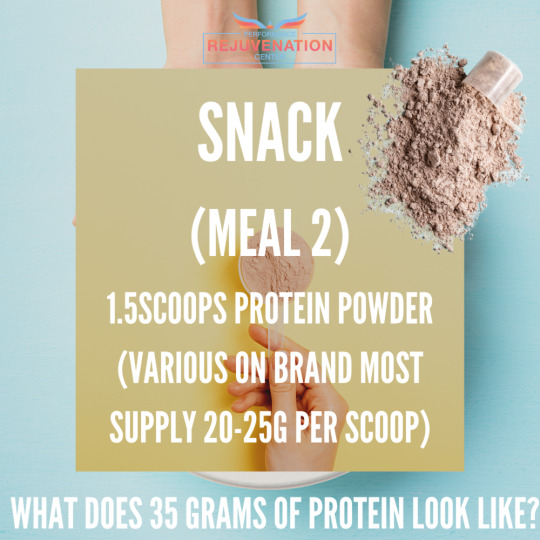
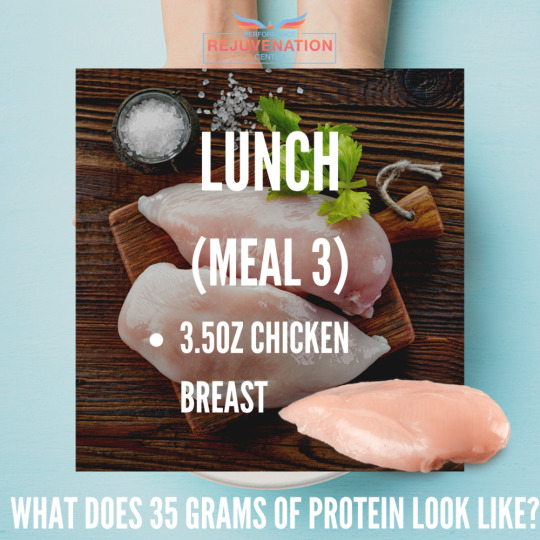
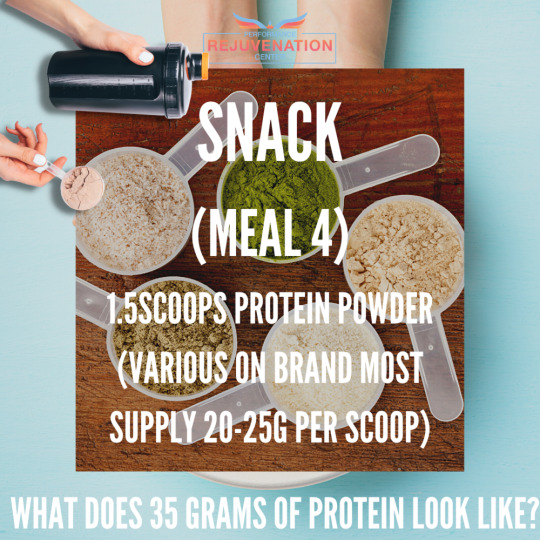
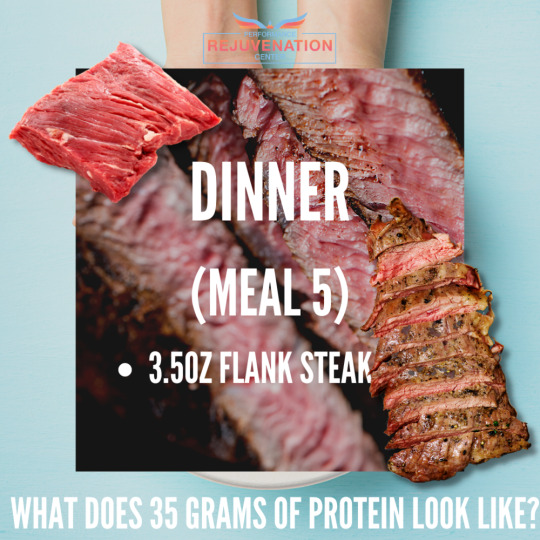
NOTE: This is just an example of how you could consume 175g of protein. It is not a suggested meal plan. You would need to add the desired amount of vegetables, carbohydrates, and fats to your daily meals for a well-rounded nutritional approach. I have found most people prefer a mix of carbs and fats for their energy requirements. We will expand on this in the future. It’s important to use a mix of protein sources, there's no magic in the sources mentioned above. These are protein sources I have favored over the years. I’ve also felt a high-quality protein shake can make meeting protein needs easier. Simply adding these 2 shakes adds 70g of protein, it’s time-efficient and involves less preparation.
Aim for 1g of protein per pound of bodyweight and over time see what differences you notice in your recovery, muscle mass, body fat percentage, energy levels, and performance. This makes it painfully easy to calculate, hop on your scale. If you weigh 190lbs, eat 190g protein, if you weigh 167lbs eat 167g; you get the idea. Divide that number by 5 meals and make a plan that’s sustainable for you to meet your protein needs! Adequate protein is especially important if you are weight training, desire to gain muscle, minimize fat gain, or optimize recovery and performance.
Best in health,
Mike Skinner
B.S. Community Health
from Washington, D.C.'s Top Anti Aging Clinic for Testosterone, Growth Hormone & Peptide Treatments https://www.prcindc.com/blog/how-much-protein-should-you-eat
0 notes
Text
Diet; Another Four Letter Word
As we move through 2021 no doubt many of us will be setting goals myself included!
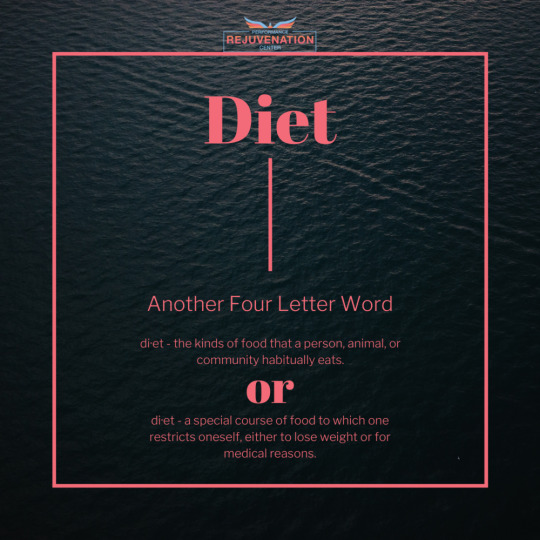
Some of the most common goals involve improving exercise routines, weight loss, and dietary habits.
How many of you have attempted fat loss before; been successful only to gain it back?
Maybe even with a few extra pounds?
Have you found quick initial results followed by a screeching halt in forward progress?
You are not alone.
Weight regain statistics can be frustrating; within a year about half will gain back all the weight they lost. Within 3 years around 95% of people will gain back all weight they lost. Unfortunately, many will end up heavier than their starting weight and the yo-yo dieting cycle is perpetuated. This article will not be providing the weight loss “answer” or specific dietary plan. I hope to point you in a direction of sustainable habits that may help you as you pursue your health and wellness goals.
Over the years I have found that for many dieting brings up thoughts such as:
Lack
Restrictions
Missing Out
Healthy Food
Low Carb
Starting and Ending
What thoughts came to your mind as you started reading? Too often a dietary approach involves eliminating or severely restricting a macronutrient. For example, A true ketogenic diet would allow for only 5-10% of your daily calories from carbohydrates (no bread, rice, potatoes, or pasta). The carnivore diet offers another extreme example – the diet includes meat, fish, and other animal foods like eggs– excluding all other foods! When your nutritional plan forces you to eliminate foods entirely or like the cases above eliminate entire macronutrient groups your ability to sustain and be consistent with your dietary plan reduces. This is not to say that the examples above or any dietary approach are innately “bad.” In fact, the structuring of most diets force people into caloric or energy deficits (you’re burning more calories than you eat) and you will lose weight. Why then do so many gain back the weight they lose? Too often a dietary plan is started that is not sustainable. When starting a diet how many of you can’t wait until the diet is over (when the weight loss goal is achieved).
In fact, one of the most important factors in a successful fat loss plan is the ability to sustain your eating habits. In order to be successful, we need something we can sustain, making small adjustments along the way to keep us progressing towards our goals. I challenge you to think- “Is this ‘new diet’ one I’ll be happy a year from now?” If not, it’s probably best to consider your current dietary habits and adopt habits that will be an improvement over what you’re doing currently.
Let’s take some of the pressure off. In truth, every single one of us is “on a diet’. Diet is defined as “the kinds of food that a person, animal, or community habitually eats” To be honest, I’ve had way too many pints of Ben & Jerry’s over the past year; Yes, the former bodybuilder struggles too! Understand you are already on a diet if you eat and we all need to eat!
If improving your eating habits is one of your goals in 2021, think about long-term habit changes. If the diet is the kinds of foods a person habitually eats, then the solution is to habitually eat nutrient-dense foods aligned with your goals. Rather than starting with restrictions, work on ADDING! If your dietary approach starts with healthy additions rather than subtractions, we can build positive associations with your changes.
What have I added?
Protein is one macronutrient I never skimped on when maximizing my performance and having a lean muscular, and strong physique was my goal. Committing to eating a protein source each time you eat is a great way to start healthier eating habits.
Here are a few reasons to consider prioritizing protein intake:
1. Protein is an essential nutrient. Nine of the 20 amino acids that make up protein are considered “essential”; your body cannot make these amino acids. Protein is the building block for our lean muscle tissue. When you ingest enough protein, muscle protein synthesis (MPS) is activated – when activated this can improve recovery, help improve your strength and increase lean muscle mass. This is especially true when combined with a weight training program.
2. Protein has a higher thermic effect when compared to carbohydrates and fats. All of the food we eat actually requires energy to be digested and assimilated into our cells. Protein is a more “expensive” macronutrient and the thermic effect of protein is somewhere between 20-30%. If you eat 100g (400 calories) of protein today 80 – 120 calories are burned during digestion and assimilation of the nutrient!
3. Protein is appetite satiating, which typically means you tend to eat less. Why? Protein is typically much more voluminous because it is not calorically dense. For example, 2 Strawberry PopTart pastries equate to 400 calories. Nearly 1 pound (~12oz) of boneless chicken breast would be needed to reach 400 calories. Which of these choices would be easier to consume? Additionally, protein has an influence on cholecystokinin CCK which has been shown to be a satiety signal.
4. If the above is not motivation enough, protein is not just something we can eat. Protein is involved in numerous body processes. Protein’s end products (amino acids) are used to create enzymes that help drive our cellular processes. It is the building block of hormones like growth hormone and IGF-1, two very important hormones shown to aid fat loss and muscle growth.

What to eat? The short answer is finding protein sources you like to eat! Over the years I’ve gravitated towards:
Eggs and Egg whites
Chicken (Breast or thighs, the latter has a bit more fat)
Turkey (93-99% lean ground)
Beef (if adding muscle I used cuts like flank/sirloin; when leaning out I stuck with leaner variety like the eye of the round)
Whey Protein Isolate
Fish (wild-caught salmon and cod)
ShellFish
No magical dietary plan or secret. I hope you’ve challenged the way you think about diet. What we eat fuels our day, performance, and quite literally our lives. Wanting to improve your physique is admirable and your efforts will be supported and sustained if your dietary practices are sensible and sustainable. Habitually prioritizing protein with your meals is a great way to start eating nutrient-dense foods aligned with your goals. Protein is a powerful macronutrient that supports many body processes and can help to improve body composition, support energy, recovery, and satiety. Do not let past associations with this four-letter word deter you. Make helpful additions to your daily diet to yield long-term benefits.
Best in health,
Mike Skinner
B.S. Community Health
from The Best Anti-Aging Clinic In Washington, DC https://www.prcindc.com/blog/diet-another-four-letter-word
0 notes
Text
You Have to Give Yourself Permission
On May 21st 2019 I was sitting on the couch with my then two-year-old son by my side. He looked up at me quietly with his hand on my thigh as I spoke to the 911 operator. I’ll never forget his little voice, “you okay, Daddy.” Of course, I wasn’t...

Moments before, I was trying to tie Wade’s shoes and knew something was wrong because I could not remember how. I became incredibly dizzy, was sweating buckets and was having difficulty seeing. I called 911. As I was explaining my symptoms to the operator, an intense pain began to build in my chest as if my heart was expelling through my sternum. I looked at my son and asked him to take my hand, which he did immediately, almost as if he was aware of the serious turn our morning had taken. Most mornings once our shoes were on, a walk around the neighborhood ensued with our dog, Winx. I told the operator I was alone with my son and that it felt, from my perspective, like I was having a heart attack.
“You okay, Daddy?” Wade repeated.
I took his hand and told him I would be, though at the time I was completely unsure. EMT’s arrived and graciously took my son from the couch to play with him and his toys while the rest of the team attended to me. My heart rate was 175 beats per minute (sitting on my couch) and my blood pressure through the roof. I was taken by ambulance to the hospital where I stabilized. After a battery of tests, we were left with more questions than answers, as sometimes this is the case. One clear problem was my non-fasted, meaning I had eaten, blood sugar was in the 40’s. The normal fasted range is 65-99mg/dL.
I will go into more of the details and the other factors that I believe led up to this strange and scary handful of days of my life in the future. For now, it’s important to know that I had walking pneumonia and was not aware. I had likely had the infection since late 2018.
When I went to my primary care physician, I reported back pain that bordered my scapula. I thought I had injured myself somehow training or possibly even lifting Wade. Those with children know they are always on the move! Additionally, I was losing weight. My appetite had been down considerably, but I was losing more than I thought appropriate based on previous experience. In hindsight, it was likely an infection that had persisted for such a long period, contributing to these issues. I never developed a persistent cough, just decreased gym performance and decreased appetite for months. I was having trouble getting enough air between sets and attributed it to poor aerobic fitness.
I thought it was possible with my work, school, and fatherhood responsibilities, that I was just more fatigued than usual and would take more time between sets. Fast forward a few months... More Time between sets wasn’t helping and the pain in my back seemed unrelenting despite multiple therapy modality attempts, partner-assisted stretching, massage, ART, dry needling, cupping – the works – with no improvements.
I consciously decided to discontinue training. The break in training has lasted 17 months, the longest time off that I have ever had since I had started training consistently 19 years ago - more than half my life. Without an impending bodybuilding contest, my good habits have fallen to the wayside and I’ve made poor dietary decisions over the past year.
Fortunately, I have hundreds of patients I interact with daily that are changing their lives for the better and have inspired me to make a change. I have had to ask myself,
“what opportunities can you find in these obstacles?” and “how can I better help others?”
The time out of the gym has given me an opportunity to reflect on those past experiences and decisions I made that I would approach differently if I “went back in time.” The truth is with such a long time off, I have an opportunity to do that; To attack the areas of my program that lacked, and I believe contributed to my injuries, poor recovery, and diminished progress.
In some ways by not practicing what I have preached for so long, I have felt hypocritical. I know most of our patients have experienced the burn out, loss of focus, low libido, decreased recovery, and performance themselves. Thus, the reason my patients are a major motivating factor for me. You prioritize yourselves and take control of your health.
As Eric has often said to me, “You have to give yourself permission.”
With that in mind, I will be making some changes to my dietary and exercise routine – starting one. Over the next few weeks and months, I will be documenting my process along the way. My genuine hope is that I can provide information through my experiences both positive and negative that can help you maximize your health and performance.
Best in health,
Mike Skinner
B.S. Community Health
from The Best Anti-Aging Clinic In Washington, DC https://www.prcindc.com/blog/giveyourselfpermission
1 note
·
View note